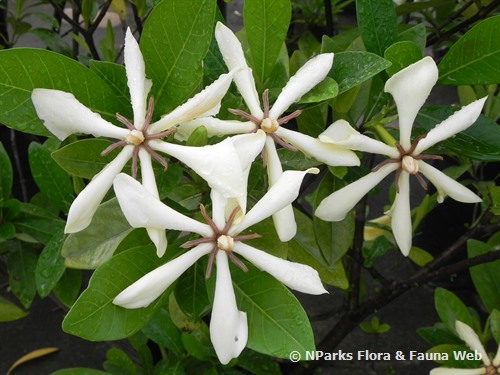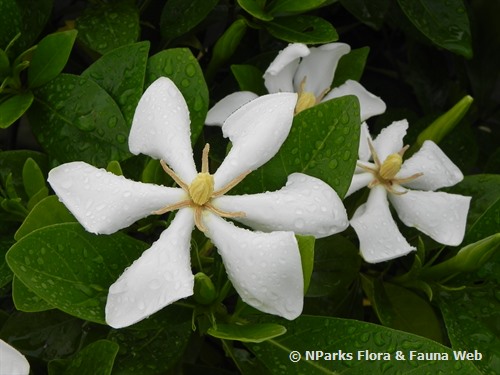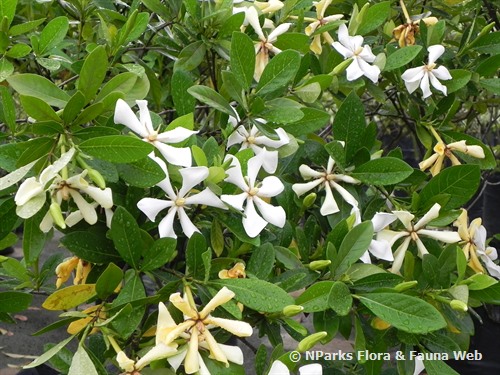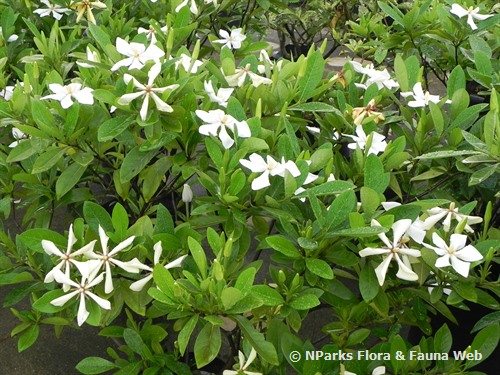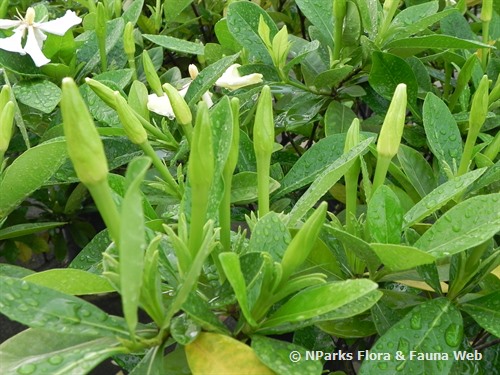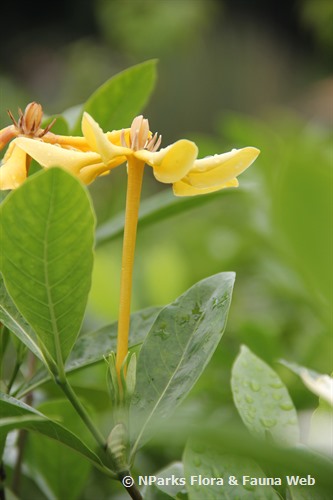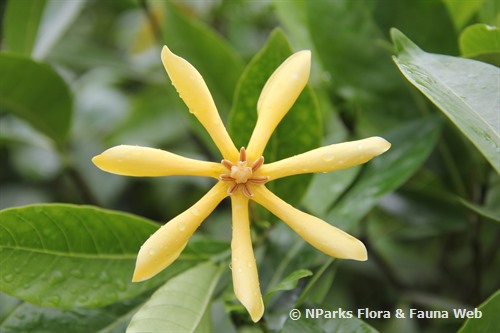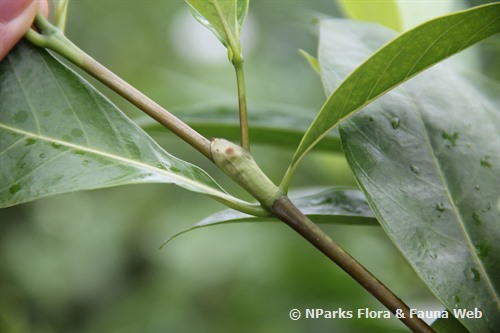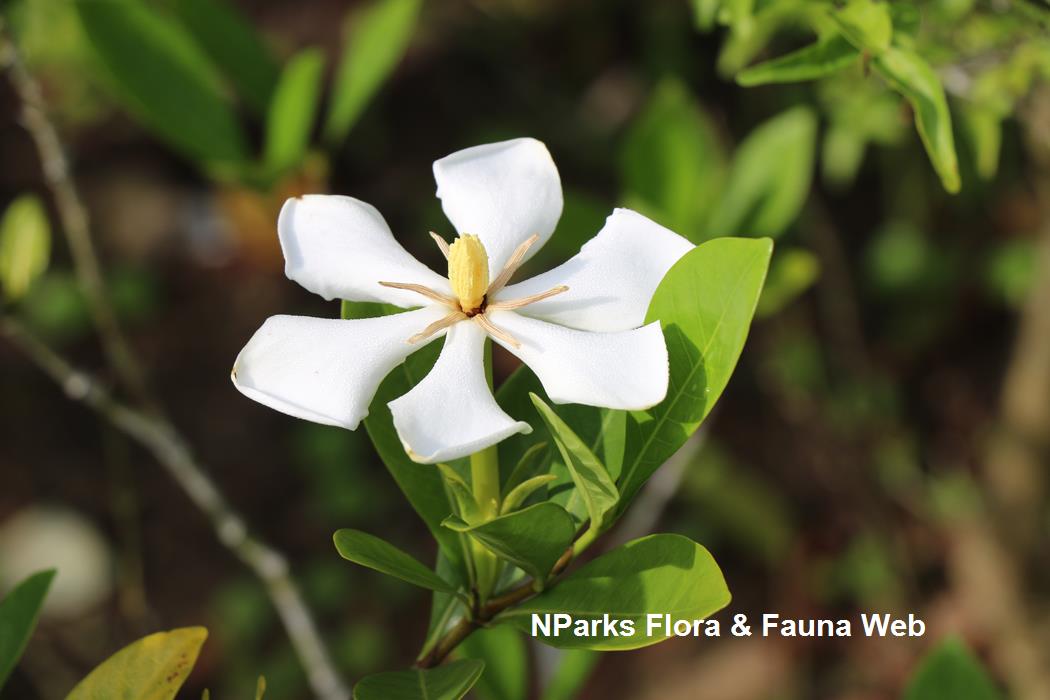
Name
Classifications and Characteristics
| Plant Division | Angiosperms (Flowering Seed Plants) (Dicotyledon) |
|---|---|
| Plant Growth Form | Shrub |
| Mode of Nutrition | Autotrophic |
Biogeography
| Native Distribution | China, Japan, Vietnam |
|---|---|
| Native Habitat | Terrestrial |
| Preferred Climate Zone | Tropical, Sub-Tropical / Monsoonal, Temperate |
Description and Ethnobotany
| Growth Form | Medium-sized, woody shrub with a rounded growth habit, able to grow up to 2 m tall. |
|---|---|
| Foliage | Semi-glossy leaves are elliptic with entire leaf margin (10 cm long, 5 cm wide). |
| Flowers | Large, white flowers have about 6 paddle-shaped petals that are arranged radially, like the spokes of a bicycle wheel (6.5 - 7.5 cm wide), turns to yellowish-white upon aging. Flowers have a strong, sweet fragrance and are produced throughout the year. |
| Cultivation | Compared with other Gardenia species, this one is easier to grow, because it is more resistant to scale insects and mealy bugs and more tolerant of drought and overwatering. This species blooms best in full sun, but also tolerates partial shade. Plant in well-draining, acidic soil that is kept moist. Mulch the plants with compost to prevent the soil from drying out or the roots from overheating. Feed plants with a palm fertilizer 3 times a year. Try not to prune this species frequently, because it is naturally bushy and flowers are produced from new growth. |
| Etymology | The genus "Gardenia" is named after Dr. Alexander Garden, an American doctor who also studied plants and animals (1730 - 1791). |
Landscaping Features
| Landscaping | This species is grown for its large, fragrant flowers. This species is suitable for container plantings and could be located on a sunny patio. Avoid planting several types or too many fragrant flowering shrubs together as the aromas could clash or become too strong. |
|---|---|
| Desirable Plant Features | Ornamental Flowers, Fragrant (Flowers) (Day) |
| Landscape Uses | Coastal, Container Planting, Parks & Gardens, Small Gardens |
Fauna, Pollination and Dispersal
| Fauna Pollination Dispersal Associated Fauna | Butterfly-Attracting |
|---|---|
| Pollination Method(s) | Biotic (Fauna) |
Plant Care and Propagation
| Light Preference | Full Sun |
|---|---|
| Water Preference | Moderate Water |
| Rootzone Tolerance | Easy to Grow, Drought Tolerant, Saline Soils / Salt Spray, Disease / Pest Resistant, Well-Drained Soils |
Foliar
| Mature Foliage Colour(s) | Green |
|---|---|
| Mature Foliage Texture(s) | Smooth |
Floral (Angiosperm)
| Flower Colour(s) | White |
|---|---|
| Flower Grouping | Solitary |
Fruit, Seed and Spore
| Mature Fruit Colour(s) | Orange |
|---|
Image Repository
Others
| Master ID | 30600 |
|---|---|
| Species ID | 4909 |
| Flora Disclaimer | The information in this website has been compiled from reliable sources, such as reference works on medicinal plants. It is not a substitute for medical advice or treatment and NParks does not purport to provide any medical advice. Readers should always consult his/her physician before using or consuming a plant for medicinal purposes. |

